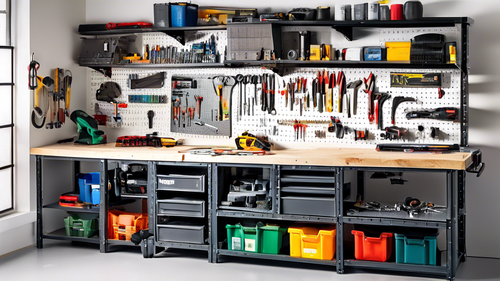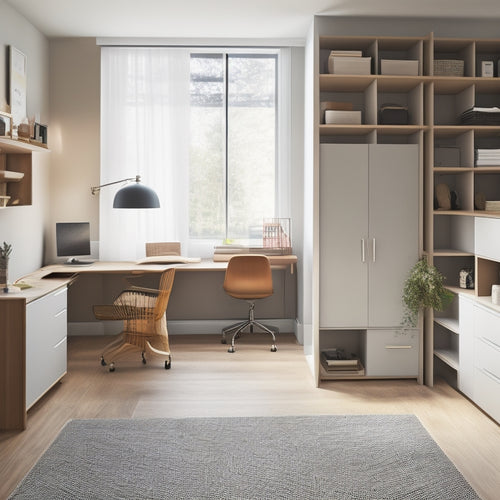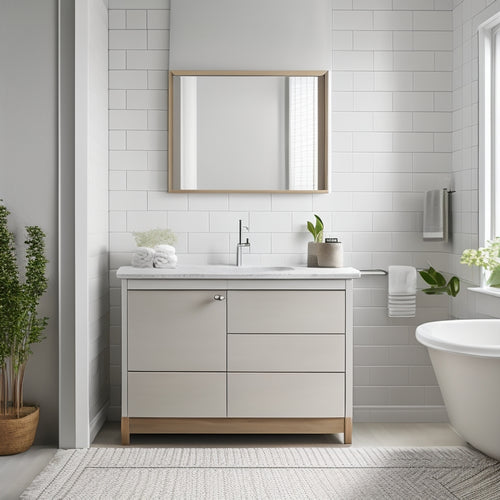
7 Essential Tips for a Clutter-Free Kitchen
Share
To achieve a clutter-free kitchen, start by purging unnecessary items and sorting them into "keep," "donate/sell," and "toss" boxes. Next, designate zones for different tasks to increase efficiency and reduce distractions. Utilize vertical storage spaces by installing shelves and hanging baskets to keep countertops clear. Implement a "one in, one out" rule to maintain a balanced space, and choose multifunctional tools to free up space. Create a daily cleaning routine and assign a home for everything to keep your kitchen organized. By following these tips, you'll be well on your way to a clutter-free kitchen where cooking is a joy - and there's more to discover.
Key Takeaways
• Purge unnecessary items by sorting them into "keep," "donate/sell," and "toss" boxes to declutter countertops and maintain a tidy kitchen.
• Designate specific zones for different tasks to streamline the cooking process, reduce movement, and stay focused.
• Utilize vertical storage spaces by installing shelves and hanging baskets to keep countertops clear and items easily accessible.
• Implement a "one in, one out" rule to replace old items, free up space, and limit new purchases to prevent clutter.
• Choose multifunctional kitchen tools to free up space, reduce clutter, and improve efficiency in the kitchen.
Purge Unnecessary Kitchen Items
Purge Unnecessary Kitchen Items
Start by gathering three boxes or bins labeled 'keep,' 'donate/sell,' and 'toss,' and then tackle every cabinet, drawer, and shelf in your kitchen to sort items into one of these categories. Be ruthless – if you haven't used it in the past year, it's probably safe to get rid of it. This will help declutter countertops and free up space for the items you really need.
Next, focus on your pantry. Take everything out and sort items into categories, such as baking supplies, spices, and snacks. Discard expired or stale items, and consider donating unopened food to a local food bank. Organize pantry items in a way that makes sense for your cooking habits, and store them in airtight containers to keep them fresh.
Designate Zones for Efficiency
Now that you've purged your kitchen of unnecessary items, it's time to think about how you can optimize your space for efficiency. By designating specific zones for different tasks, you'll be able to move quickly and easily through your kitchen routines.
You'll want to create zones that make sense for your cooking style and the types of tasks you perform most frequently.
Zone Assignments Matter
By designating specific zones in your kitchen, you'll be able to streamline your cooking process and reduce clutter. This efficiency organization strategy allows you to create a functional layout that makes sense for your cooking habits.
Start by identifying the activities you perform most frequently in your kitchen, such as food prep, cooking, and cleanup. Then, assign a specific zone for each activity, ensuring that the tools and ingredients needed for each task are within easy reach.
For example, you might designate a zone near the sink for food prep, with a trash can, cutting board, and utensils nearby. A cooking zone near the stove could include pots, pans, and cooking utensils. By grouping similar tasks together, you'll reduce the need to constantly move around the kitchen, saving time and energy.
A well-organized kitchen with designated zones will also help you stay focused and avoid distractions, allowing you to cook with confidence and precision. By implementing zone assignments, you'll be able to cook more efficiently and maintain a clutter-free kitchen.
Task-Based Station Setup
Designate specific stations within each zone to further maximize efficiency, such as a coffee spot, baking area, or meal prep corner, each equipped with the necessary tools and ingredients to simplify your workflow. This task-based station setup will revolutionize your kitchen's productivity. By grouping similar tasks together, you'll reduce shift time and mental fatigue, allowing you to focus on the task at hand.
Imagine having all your coffee essentials in one place, so you can quickly brew a cup and start your day off right.
Picture a clutter-free countertop, where you can spread out your ingredients and cook with ease, without wasting time searching for misplaced items.
Envision the sense of accomplishment you'll feel when you've streamlined your meal prep, and can whip up a healthy meal in no time.
Utilize Vertical Storage Spaces
How can you maximize your kitchen's storage potential when floor and counter space are limited? By utilizing vertical storage spaces, you can create a clutter-free kitchen that's both functional and visually appealing. Start by installing wall shelves to store infrequently used items, such as special occasion dishes or cookbooks. This will keep them out of the way but still accessible when needed.
Next, consider hanging baskets to store items like pots, pans, utensils, and even cleaning supplies. Not only do they add a decorative touch, but they also keep your countertops clear and make it easy to find what you need quickly. You can also use hanging baskets to store snacks, spices, or oils, keeping them within easy reach.
Implement a "One In, One Out" Rule
As you work towards a clutter-free kitchen, embracing a 'one in, one out' mindset is crucial. This means that every time you introduce a new item into your kitchen, you'll dispose of an old one to create space for it.
Replace Old Items
Get rid of outdated cookware, utensils, and gadgets by adopting a 'one in, one out' rule, where you replace an old item every time you bring a new one into your kitchen. This simple rule will help you maintain a balanced amount of kitchen essentials and prevent clutter from building up.
Here are some benefits of replacing old items:
-
Free up space: By getting rid of old, broken, or redundant items, you'll create more space in your kitchen for the things you really need.
-
Reduce waste: Donate or recycle old items instead of throwing them away, and you'll reduce your environmental impact.
-
Upgrade to essentials: When you replace old items, you can upgrade to better-quality essentials that will make cooking easier and more enjoyable.
Limit New Purchases
By implementing the 'one in, one out' rule, you'll curb the temptation to impulse buy kitchen gadgets and tools, keeping your kitchen clutter-free and organized. This simple yet effective strategy safeguards that for every new item you bring into your kitchen, an old one must be removed, maintaining a balanced and sustainable space.
| New Purchase | Outdated Item | Why It Works |
|---|---|---|
| Stand Mixer | Old Hand Mixer | Upgrades efficiency, reduces clutter |
| Silicone Spatulas | Worn-Out Wooden Spatulas | Improves cooking experience, minimizes waste |
| Instant Pot | Slow Cooker | Streamlines cooking process, optimizes storage |
| Reusable Containers | Disposable Takeout Containers | Promotes eco-friendliness, reduces waste |
Choose Multifunctional Kitchen Tools
Streamline your kitchen drawers and countertops by investing in multifunctional tools that can perform several tasks with ease. This approach won't only free up space but also reduce clutter, making your kitchen more efficient and organized.
Multifunctional tools are space saving gadgets that can help you achieve kitchen tool organization. Here are a few examples:
-
A stand mixer that can also knead dough and whip cream
-
A food processor that can chop, slice, and puree ingredients
-
A silicone spatula that can scrape the sides of the bowl, flip pancakes, and serve as a spoon
Create a Daily Cleaning Routine
You'll be more likely to uphold your newly organized kitchen tools if you establish a daily cleaning regimen that keeps clutter at bay. By incorporating a few simple habits into your daily routine, you'll save time in the long run and guarantee your kitchen remains tidy.
Daily Cleaning Regimen Checklist
| Task | Time | Frequency |
|---|---|---|
| Wipe down countertops | 5 minutes | After every meal |
| Put away dishes | 10 minutes | After every meal |
| Sweep/vacuum floor | 10 minutes | Daily |
Assign a Home for Everything
Designate a specific spot for each item in your kitchen, ensuring that everything has a designated home where it can be easily found and returned to after use. This will help you maintain a clutter-free kitchen by keeping everything in its place. By doing so, you'll save time searching for misplaced items, reduce stress, and increase productivity.
Here are a few benefits you can expect when you assign a home for everything:
-
Effortless meal prep: With all utensils and ingredients within reach, you'll be able to whip up a meal in no time.
-
Reduced frustration: No more searching for that one specific spice or utensil - it's exactly where it's supposed to be.
-
A sense of control: A clutter-free kitchen gives you a sense of power and control over your cooking environment.
Frequently Asked Questions
How Do I Declutter Sentimental Kitchen Items, Like Grandma's Old Cookbook?
When decluttering sentimental kitchen items like grandma's old cookbook, you'll face emotional attachment. Start by acknowledging the sentiment, then consider digitizing the recipes or creating a memory box to store a few cherished items, freeing up space while preserving the memories.
What if I Have Limited Kitchen Counter and Floor Space for Zones?
You're solving a puzzle, fitting pieces together to maximize space. Optimize your kitchen's vertical storage with creative solutions like wall-mounted shelves and racks. Invest in multi-functional furniture and compact, space-saving small appliances to free up floor space.
Are Over-The-Sink Shelves Difficult to Install and Maintain?
You'll find over-the-sink shelves relatively easy to install, but maintenance can be tricky, especially when cleaning around sink fixtures; however, with the right storage solutions, you'll master sink organization and keep your space clutter-free.
Can a 'One In, One Out' Rule Be Applied to Kitchen Gadgets and Tools?
Imagine having to choose between your new stand mixer and your old food processor. You implement the "one in, one out" rule by letting go of the old to make room for the new, organizing gadgets and tools in a clutter-free space.
How Often Should I Reassess and Adjust My Kitchen Organization System?
You should reassess and adjust your kitchen organization system every 3-6 months to guarantee storage solutions remain effective and organization hacks boost efficiency, making the most of your space and time.
Related Posts
-

Garage Workbench Organization
Garage Workbench Organization: A Guide to Maximizing Space and Efficiency Are you tired of a cluttered and unorgan...
-

7 Essential Storage Hacks for Small Spaces
You're likely no stranger to the frustrations of living in a small space, where clutter can quickly accumulate and ma...
-

Why Bathroom Storage Matters for a Clutter-Free Home
You recognize that a clutter-free bathroom is essential to your daily routine, but did you know that clever bathroom ...


